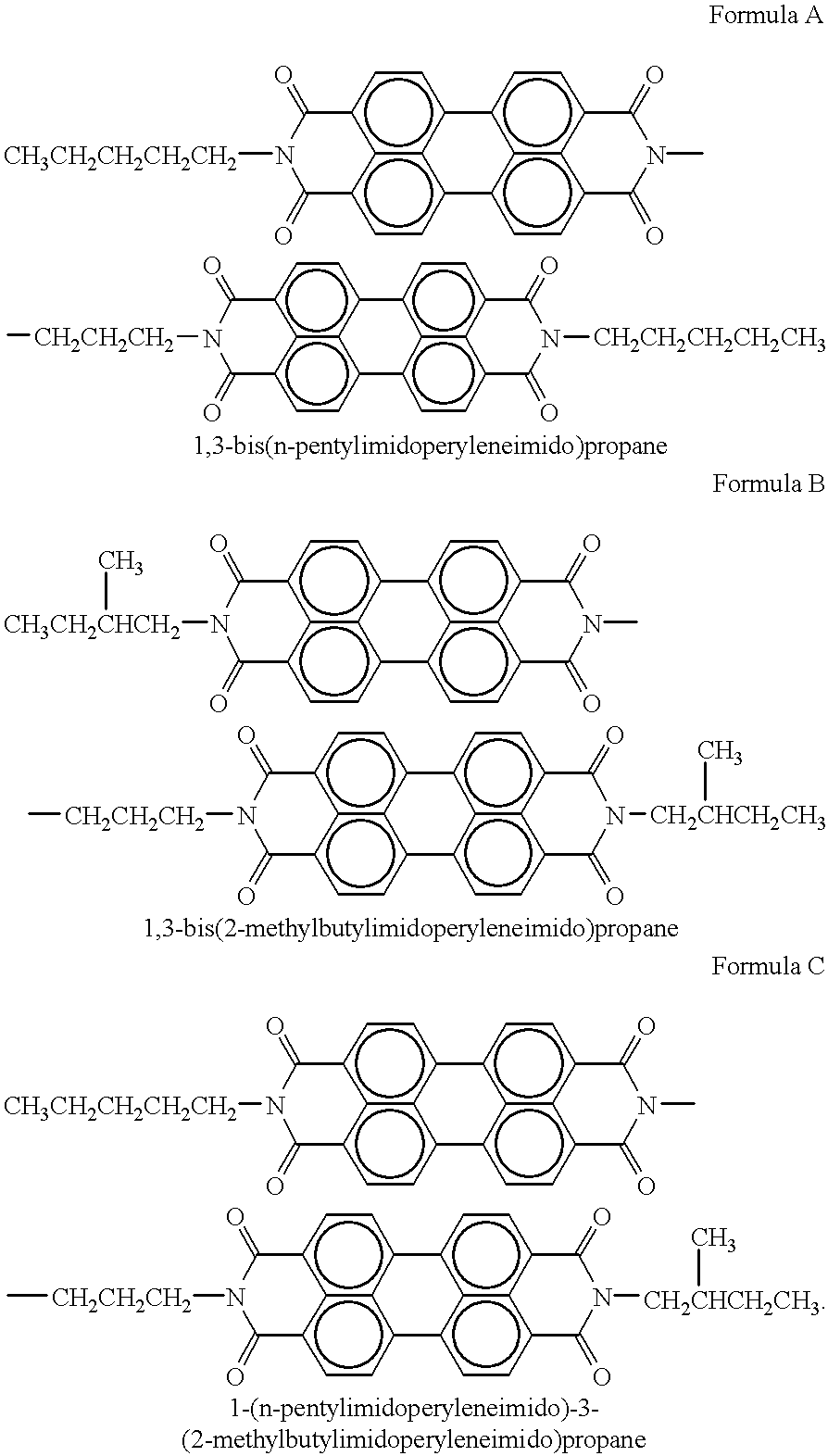Imaging members
a technology of imaging members and spectral response ranges, applied in the field of imaging members, can solve the problems of poor dispersion quality, narrow spectral response range, low photosensitivity,
- Summary
- Abstract
- Description
- Claims
- Application Information
AI Technical Summary
Problems solved by technology
Method used
Image
Examples
example i
DEVICE EXAMPLE I
Xerographic Evaluation of Perylene Dimer Compositions Containing an Electron Transport Dopant:
Photoresponsive imaging members were fabricated with the mixed perylene dimer A, B and C of Synthesis Example I and different electron acceptor dopant materials listed in Table A to form the photogenerator layer. The photogenerator layer contained about 81.5 weight percent of the perylene pigment mixture, 18.5 weight percent of polyvinylbutyral polymer binder (PVB, available from Monsanto as B79) and of the 81.5 percent, the perylene mixture containing the above three perylenes was present in an amount of about 74.1 weight percent, and the dopant was present in the mixture in an amount of about 7.4 weight percent. The relative weight ratio of dopant to the perylene mixture was 1:10.
The photogenerator layer thus contained about 18.5 weight percent or parts of PVB and about 81.5 weight percent of perylene mixture containing the three perylene dimers and dopant. Of this 81.5 pe...
example ii
DEVICE EXAMPLE II
Xerographic Evaluation of Perylene Dimer Mixture Containing Carbazole Dopants:
Photoresponsive imaging members of the perylene dimer mixture containing different kinds of carbazole molecules as a dopant were fabricated in accordance with the procedure of Device Example I except that photogenerator layers contained 42 weight percent of PVB and 58 weight percent of the perylene mixed pigment and dopant. The photogenerator layer was prepared from a pigment dispersion of 0.2 gram of the above prepared mixed perylene dimer, 0.02 gram of dopant material, 0.3 gram of polyvinylbutyral (PVB) polymer, 3.5 grams of tetrahydrofuran (THF), and 3.5 grams of toluene. The dopants were as indicated and the xerographic electrical results obtained for the resulting imaging members studied are provided in Table 2.
The results in Table 2 indicate that carbazole dopants generally improve the photosensitivity (i.e. reduced E.sub.1 / 2 value) of the perylene dimer photogenerator mixture layer....
example iii
DEVICE EXAMPLE III
Photosensitivity Concentration of Polyvinylcarbazole Dopant:
Primarily to determine the influence of the concentration of the polyvinylcarbazole (PVK) on xerographic performance, a series of photoresponsive imaging members incorporating different amounts of dopant were fabricated as illustrated in Device Example II. The amount of mixed perylene dimer was kept constant at 0.2 gram. The weight ratio of perylene to PVK varied from 100:1 to 100:10. The composition of the photogenerating layer and corresponding xerographic electricals are shown in Table 3.
The photosensitivity of perylene dimer increased (i.e. half-exposure energy E.sub.1 / 2 decreases) with increasing amount of polyvinylcarbazole dopant added to the photogenerator layer. There was some increase in dark decay, but the value remains reasonable for practical applications even at the highest doping level used.
Imaging members as illustrated above with an electron acceptor polymer of PMMA-BCFM exhibited the foll...
PUM
 Login to View More
Login to View More Abstract
Description
Claims
Application Information
 Login to View More
Login to View More - R&D
- Intellectual Property
- Life Sciences
- Materials
- Tech Scout
- Unparalleled Data Quality
- Higher Quality Content
- 60% Fewer Hallucinations
Browse by: Latest US Patents, China's latest patents, Technical Efficacy Thesaurus, Application Domain, Technology Topic, Popular Technical Reports.
© 2025 PatSnap. All rights reserved.Legal|Privacy policy|Modern Slavery Act Transparency Statement|Sitemap|About US| Contact US: help@patsnap.com



